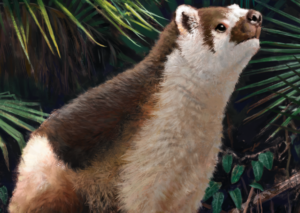Ancient mammals lived fast and died young
Some prehistoric mammals were born ready-to-go and grew up twice as fast as today’s mammals, giving them an edge after the dinosaur extinction, a study suggests.
Research indicates that their long pregnancies explain why our early ancestors rose to prominence, some 62 million years ago, and dominated territories previously occupied by Tyrannosaurus rex, Triceratops and other giant dinosaurs.
An international team, partnering geochemists from the University of St Andrews in collaboration with the University of Edinburgh, Carnegie Museum of Natural History, and New Mexico Museum of Natural History and Science, used dental analysis to uncover the life history of Pantolambda bathmodon – a member of the earliest known group of herbivores, that grew to about the size of a sheep, in the post-dinosaur era.
Scientists examined razor thin sections of P. bathmodon’s teeth, which revealed the mammal’s daily growth lines, also known as bands. The team also used lasers to vaporize the teeth to expose its chemical make-up.
Chemical changes in the teeth showed major transitions in early life, including high levels of zinc deposited at birth, and enrichment with barium during the suckling period. This is the oldest fossil where these results have been seen – some 60 million years more ancient than the previous record-holder, according to researchers.
The findings, published in Nature, suggest that P. bathmodon mothers were pregnant for just under seven months and gave birth to single, well-developed babies, sporting a full mouthful of teeth. Their babies, probably mobile from day one, suckled for only one to two months before they became fully independent.

Although the inferred gestation time matches that of today’s similarly sized mammals, this early mammal is found to have lived and died more rapidly by comparison. The data shows that P. bathmodon were independent and ready to mate before their first birthday, and lived only 3 to 4 years on average, whereas most mammals of similar size today live 20 years or more, experts say.
Lead author, Dr Gregory Funston, Royal Society Newton International Fellow, University of Edinburgh, currently based at the Royal Ontario Museum, Toronto, said: “Our research opens the most detailed window to date into the daily lives of extinct mammals.
“This unprecedented level of detail shows the kinds of lifestyles that make placental mammals special, evolved early in their evolutionary history.
“We think that their babies’ longer gestation period could have nurtured large body sizes faster than other mammals, which may be why they became the dominant mammals of today.”
Dr James Rae, Reader in Earth and Environmental Sciences at the University of St Andrews, said: “our laser analyses reveal the chemical fingerprints of ancient physiology with unprecedented detail, allowing us to reconstruct the intimate history of day to day life in these ancient mammals.”
“We conducted this research at the same time as I had a baby of my own and I found it just amazing to see the imprints of the early days of life in another baby mammal, born 60 million years before my daughter. I just hope that those early mammal parents got more sleep!”
The research was funded by Royal Society Newton Fellowship, ERC, NSF, and SNSF.